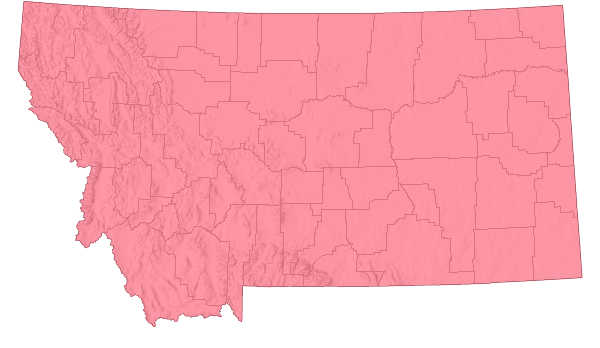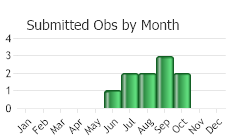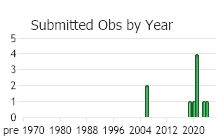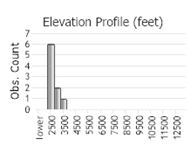View in other NatureServe Network Field Guides
NatureServe
Montana
Utah
Wyoming
Idaho
Wisconsin
British Columbia
South Carolina
Yukon
California
New York
Pennsylvania Smartweed - Polygonum pensylvanicum
Other Names:
Persicaria pensylvanica
Non-native Species
Global Rank:
G5
State Rank:
SNA
(see State Rank Reason below)
C-value:
Agency Status
USFWS:
USFS:
BLM:
External Links
State Rank Reason (see State Rank above)
This plant has been observed once in Montana in a garden in 2006. This species is considered exotic in Montana.
General Description
Plants: Taprooted, highly branched upright annual (McGregor et al. 1986), up to 2 m tall (FNA 2005).
Leaves: Blades lance-shaped, sometimes gradually narrowing to the sharp apex (McGregor et al. 1986), up to 23 cm in length and to nearly 5 cm in width, sometimes with glandular pits on the upper surface, less often on the lower, the bases tapered or wedge-shaped (FNA 2005); ocreae glabrous or slightly hairy, tubular and sheathing the nodes (McGregor et al. 1986), papery, brownish, the stipule margins with or without ciliate bristles; petioles to 3 cm in length, smooth or with hairs flattened to the stem (FNA 2005).
Inflorescences: Many cylindrical, spikelike racemes throughout much of the plant, dense (McGregor et al. 1986) with 2-14 flowers per ocreate bundle, uninterrupted, terminal or axillary, 0.5-5 cm in length, 0.5-1.5 cm in width; pedicels 1.5-4.5 mm in length, reaching upward (FNA 2005).
Phenology
Flowering May-December (FNA 2005).
Species Range
Montana Range
Range Descriptions

 Non-native
Non-native
Range Comments
Eastern Canada, west to Ontario; throughout most of the eastern United States and the Great Plains, extending west to MT, UT, and CA, including AK (absent in PNW) (FNA 2005). In Montana, Pennsylvania Smartweed was collected once from a garden in Fallon County (Lesica 2012).
(P. Lesica's contribution adapted from Lesica et al. 2012. Manual of Montana Vascular Plants. BRIT Press. Fort Worth, TX)
Observations in Montana Natural Heritage Program Database
Number of Observations: 12
(Click on the following maps and charts to see full sized version)
Map Help and Descriptions
Relative Density

Recency



 (Observations spanning multiple months or years are excluded from time charts)
(Observations spanning multiple months or years are excluded from time charts)
Habitat
Damp, disturbed areas, fields and roadsides (McGregor 1986), shores of rivers, ponds and reservoirs (FNA 2005).
Ecology
POLLINATORS The following animal species have been reported as pollinators of this plant species or its genus where their geographic ranges overlap:
Bombus bifarius,
Bombus flavifrons,
Bombus frigidus,
Bombus melanopygus,
Bombus sylvicola,
Bombus occidentalis,
Bombus pensylvanicus,
Bombus insularis, and
Bombus kirbiellus (Macior 1974, Colla and Dumesh 2010).
Reproductive Characteristics
Flowers: Perianth 3-5 mm in length, sometimes with resinous glands (McGregor et al. 1986), white with pale green or rosy pink; tepals 5, fused for the bottom 1/3, with conspicuous veins, smooth margins, and an apex rounded or nearly so (FNA 2005); stamens and styles equal, not exserted beyond the perianth (McGregor et al. 1986), the stamens 8 with anthers yellow to red, the styles 2 or 3 with bases partially fused (FNA 2005); glandular disk present at base of ovary (McGregor et al. 1986).
Fruit: Achene resembling a disk or seldom 3-angled, then concave on only 2 faces, shiny, black or brown (FNA 2005).
Management
Stewardship Responsibility
References
- Literature Cited AboveLegend:
 View Online Publication
View Online Publication Colla, S.R. and S. Dumesh. 2010. The bumble bees of southern Ontario: notes on natural history and distribution. Journal of the Entomological Society of Ontario 141:39-68.
Colla, S.R. and S. Dumesh. 2010. The bumble bees of southern Ontario: notes on natural history and distribution. Journal of the Entomological Society of Ontario 141:39-68. Flora of North America Editorial Committee. 2005. Flora of North America North of Mexico. Volume 5. Magnoliophyta: Caryophyllidae: Caryophyllales, Polygonales, and Plumbaginales. New York, NY: Oxford Univ. Press. vii + 656 pp.
Flora of North America Editorial Committee. 2005. Flora of North America North of Mexico. Volume 5. Magnoliophyta: Caryophyllidae: Caryophyllales, Polygonales, and Plumbaginales. New York, NY: Oxford Univ. Press. vii + 656 pp. Lesica, P., M.T. Lavin, and P.F. Stickney. 2012. Manual of Montana Vascular Plants. Fort Worth, TX: BRIT Press. viii + 771 p.
Lesica, P., M.T. Lavin, and P.F. Stickney. 2012. Manual of Montana Vascular Plants. Fort Worth, TX: BRIT Press. viii + 771 p. Macior, L.M. 1974. Pollination ecology of the Front Range of the Colorado Rocky Mountains. Melanderia 15: 1-59.
Macior, L.M. 1974. Pollination ecology of the Front Range of the Colorado Rocky Mountains. Melanderia 15: 1-59. McGregor, R.L. (coordinator), T.M. Barkley, R.E. Brooks, and E.K. Schofield (eds). 1986. Flora of the Great Plains: Great Plains Flora Association. Lawrence, KS: Univ. Press Kansas. 1392 pp.
McGregor, R.L. (coordinator), T.M. Barkley, R.E. Brooks, and E.K. Schofield (eds). 1986. Flora of the Great Plains: Great Plains Flora Association. Lawrence, KS: Univ. Press Kansas. 1392 pp.
- Additional ReferencesLegend:
 View Online Publication
View Online Publication
Do you know of a citation we're missing? Britton, N. L. and A. B. Brown. 1913. An Illustrated Flora of the Northern United States, Canada, and the British Possessions. 2nd Edition in 3 Volumes. New York, NY: Charles Scribner's Sons. B13BRI01PAUS.
Britton, N. L. and A. B. Brown. 1913. An Illustrated Flora of the Northern United States, Canada, and the British Possessions. 2nd Edition in 3 Volumes. New York, NY: Charles Scribner's Sons. B13BRI01PAUS. Lesica, P., M.T. Lavin, and P.F. Stickney. 2022. Manual of Montana Vascular Plants, Second Edition. Fort Worth, TX: BRIT Press. viii + 779 p.
Lesica, P., M.T. Lavin, and P.F. Stickney. 2022. Manual of Montana Vascular Plants, Second Edition. Fort Worth, TX: BRIT Press. viii + 779 p.
- Web Search Engines for Articles on "Pennsylvania Smartweed"





